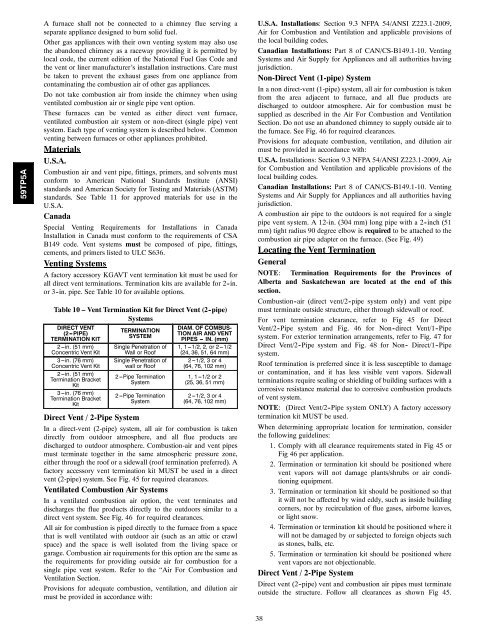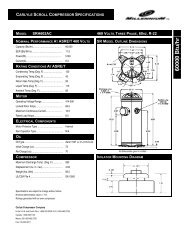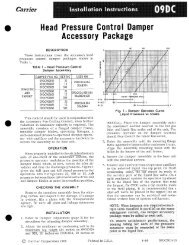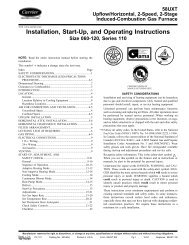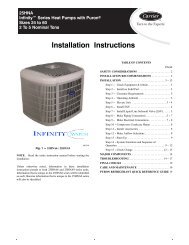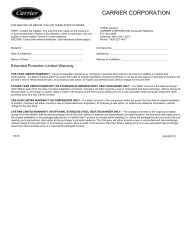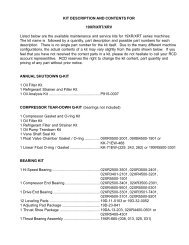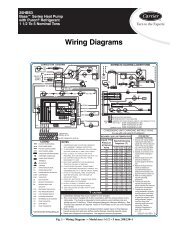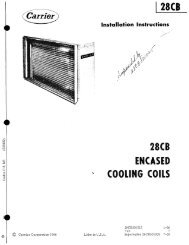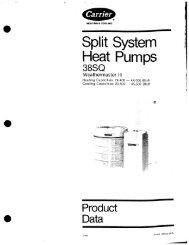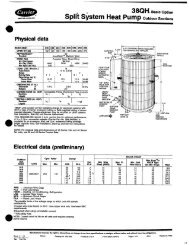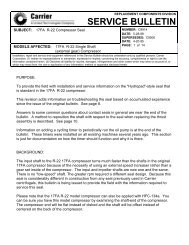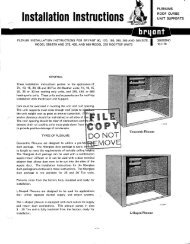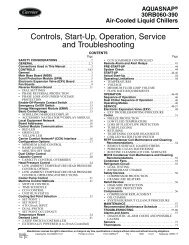warning - Docs.hvacpartners.com
warning - Docs.hvacpartners.com
warning - Docs.hvacpartners.com
You also want an ePaper? Increase the reach of your titles
YUMPU automatically turns print PDFs into web optimized ePapers that Google loves.
59TP5AA furnace shall not be connected to a chimney flue serving aseparate appliance designed to burn solid fuel.Other gas appliances with their own venting system may also usethe abandoned chimney as a raceway providing it is permitted bylocal code, the current edition of the National Fuel Gas Code andthe vent or liner manufacturer’s installation instructions. Care mustbe taken to prevent the exhaust gases from one appliance fromcontaminating the <strong>com</strong>bustion air of other gas appliances.Do not take <strong>com</strong>bustion air from inside the chimney when usingventilated <strong>com</strong>bustion air or single pipe vent option.These furnaces can be vented as either direct vent furnace,ventilated <strong>com</strong>bustion air system or non-direct (single pipe) ventsystem. Each type of venting system is described below. Commonventing between furnaces or other appliances prohibited.MaterialsU.S.A.Combustion air and vent pipe, fittings, primers, and solvents mustconform to American National Standards Institute (ANSI)standards and American Society for Testing and Materials (ASTM)standards. See Table 11 for approved materials for use in theU.S.A.CanadaSpecial Venting Requirements for Installations in CanadaInstallation in Canada must conform to the requirements of CSAB149 code. Vent systems must be <strong>com</strong>posed of pipe, fittings,cements, and primers listed to ULC S636.Venting SystemsA factory accessory KGAVT vent termination kit must be used forall direct vent terminations. Termination kits are available for 2 -in.or 3 -in. pipe. See Table 10 for available options.Table 10 – Vent Termination Kit for Direct Vent (2 -pipe)SystemsDIRECT VENT(2---PIPE)TERMINATION KIT2 --- in. (51 mm)Concentric Vent Kit3 --- in. (76 mm)Concentric Vent Kit2 --- in. (51 mm)Termination BracketKit3 --- in. (76 mm)Termination BracketKitTERMINATIONSYSTEMSingle Penetration ofWall or RoofSingle Penetration ofwall or Roof2---Pipe TerminationSystem2---Pipe TerminationSystemDIAM. OF COMBUS-TION AIR AND VENTPIPES --- IN. (mm)1, 1---1/2, 2, or 2---1/2(24, 36, 51, 64 mm)2---1/2, 3 or 4(64, 76, 102 mm)1, 1---1/2 or 2(25, 36, 51 mm)2---1/2, 3 or 4(64, 76, 102 mm)Direct Vent / 2-Pipe SystemIn a direct-vent (2-pipe) system, all air for <strong>com</strong>bustion is takendirectly from outdoor atmosphere, and all flue products aredischarged to outdoor atmosphere. Combustion-air and vent pipesmust terminate together in the same atmospheric pressure zone,either through the roof or a sidewall (roof termination preferred). Afactory accessory vent termination kit MUST be used in a directvent (2-pipe) system. See Fig. 45 for required clearances.Ventilated Combustion Air SystemsIn a ventilated <strong>com</strong>bustion air option, the vent terminates anddischarges the flue products directly to the outdoors similar to adirect vent system. See Fig. 46 for required clearances.All air for <strong>com</strong>bustion is piped directly to the furnace from a spacethat is well ventilated with outdoor air (such as an attic or crawlspace) and the space is well isolated from the living space orgarage. Combustion air requirements for this option are the same asthe requirements for providing outside air for <strong>com</strong>bustion for asingle pipe vent system. Refer to the “Air For Combustion andVentilation Section.Provisions for adequate <strong>com</strong>bustion, ventilation, and dilution airmust be provided in accordance with:U.S.A. Installations: Section 9.3 NFPA 54/ANSI Z223.1-2009,Air for Combustion and Ventilation and applicable provisions ofthe local building codes.Canadian Installations: Part 8 of CAN/CS-B149.1-10. VentingSystems and Air Supply for Appliances and all authorities havingjurisdiction.Non-Direct Vent (1-pipe) SystemIn a non direct-vent (1-pipe) system, all air for <strong>com</strong>bustion is takenfrom the area adjacent to furnace, and all flue products aredischarged to outdoor atmosphere. Air for <strong>com</strong>bustion must besupplied as described in the Air For Combustion and VentilationSection. Do not use an abandoned chimney to supply outside air tothe furnace. See Fig. 46 for required clearances.Provisions for adequate <strong>com</strong>bustion, ventilation, and dilution airmust be provided in accordance with:U.S.A. Installations: Section 9.3 NFPA 54/ANSI Z223.1-2009, Airfor Combustion and Ventilation and applicable provisions of thelocal building codes.Canadian Installations: Part 8 of CAN/CS-B149.1-10. VentingSystems and Air Supply for Appliances and all authorities havingjurisdiction.A <strong>com</strong>bustion air pipe to the outdoors is not required for a singlepipe vent system. A 12-in. (304 mm) long pipe with a 2 -inch (51mm) tight radius 90 degree elbow is required to be attached to the<strong>com</strong>bustion air pipe adapter on the furnace. (See Fig. 49)Locating the Vent TerminationGeneralNOTE: Termination Requirements for the Provinces ofAlberta and Saskatchewan are located at the end of thissection.Combustion -air (direct vent/2 -pipe system only) and vent pipemust terminate outside structure, either through sidewall or roof.For vent termination clearance, refer to Fig 45 for DirectVent/2 -Pipe system and Fig. 46 for Non -direct Vent/1 -Pipesystem. For exterior termination arrangements, refer to Fig. 47 forDirect Vent/2 -Pipe system and Fig. 48 for Non - Direct/1 -Pipesystem.Roof termination is preferred since it is less susceptible to damageor contamination, and it has less visible vent vapors. Sidewallterminations require sealing or shielding of building surfaces with acorrosive resistance material due to corrosive <strong>com</strong>bustion productsof vent system.NOTE: (Direct Vent/2 -Pipe system ONLY) A factory accessorytermination kit MUST be used.When determining appropriate location for termination, considerthe following guidelines:1. Comply with all clearance requirements stated in Fig 45 orFig 46 per application.2. Termination or termination kit should be positioned wherevent vapors will not damage plants/shrubs or air conditioningequipment.3. Termination or termination kit should be positioned so thatit will not be affected by wind eddy, such as inside buildingcorners, nor by recirculation of flue gases, airborne leaves,or light snow.4. Termination or termination kit should be positioned where itwill not be damaged by or subjected to foreign objects suchas stones, balls, etc.5. Termination or termination kit should be positioned wherevent vapors are not objectionable.Direct Vent / 2-Pipe SystemDirect vent (2 -pipe) vent and <strong>com</strong>bustion air pipes must terminateoutside the structure. Follow all clearances as shown Fig 45.38


